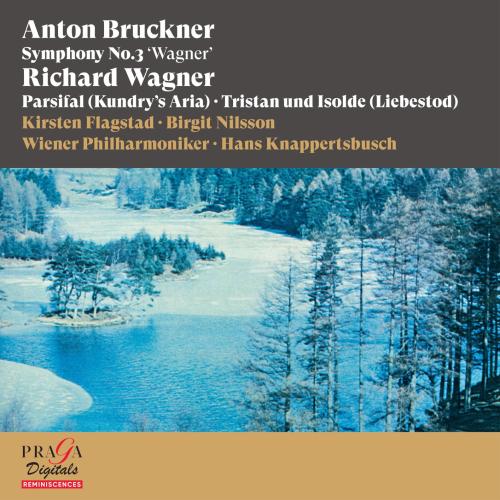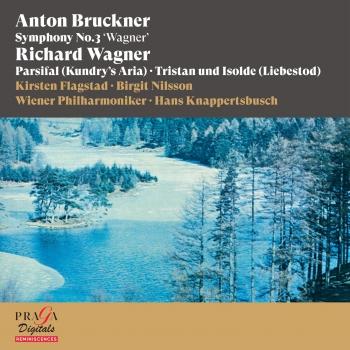
Anton Bruckner: Symphony No. 3 "Wagner" - Richard Wagner: Parsifal (Kundry's Aria), Tristan und Isolde (Prelude & Liebestod) Hans Knappertsbusch, Wiener Philharmoniker, Kirsten Flagstad, Birgit Nilsson
Album Info
Album Veröffentlichung:
2022
HRA-Veröffentlichung:
06.05.2022
Label: Praga Digitals
Genre: Classical
Subgenre: Vocal
Interpret: Hans Knappertsbusch, Wiener Philharmoniker, Kirsten Flagstad, Birgit Nilsson
Komponist: Anton Bruckner (1824-1896), Richard Wagner (1813-1883)
Das Album enthält Albumcover Booklet (PDF)
- Anton Bruckner (1824 - 1896): Symphony No. 3 in D Minor, WAB 103 "Wagner":
- 1 Bruckner: Symphony No. 3 in D Minor, WAB 103 "Wagner": I. Mäßig bewegt 19:09
- 2 Bruckner: Symphony No. 3 in D Minor, WAB 103 "Wagner": II. Adagio. Etwas bewegt. Quasi andante 14:06
- 3 Bruckner: Symphony No. 3 in D Minor, WAB 103 "Wagner": III. Scherzo. Ziemlich schnell 07:20
- 4 Bruckner: Symphony No. 3 in D Minor, WAB 103 "Wagner": IV. Finale. Allegro 13:24
- Parsifal, WWV 111, Act II:
- 5 Wagner: Parsifal, WWV 111, Act II: Ich sah das Kind an seiner Mutter Brust (Kundry's Aria) 05:53
- Tristan und Isolde, WWV 90:
- 6 Wagner: Tristan und Isolde, WWV 90: Prelude 10:14
- Tristan und Isolde, WWV 90, Act III:
- 7 Wagner: Tristan und Isolde, WWV 90, Act III: Mild und leise wie er lächelt (Liebestod) 07:03
Info zu Anton Bruckner: Symphony No. 3 "Wagner" - Richard Wagner: Parsifal (Kundry's Aria), Tristan und Isolde (Prelude & Liebestod)
Bruckner's Third Symphony has been characterised as 'difficult', and is regarded by some as his artistic breakthrough. According to Rudolf Kloiber, this symphony 'opens the sequence of Bruckner's masterpieces, in which his creativity meets monumental ability of symphonic construction.' The work is notorious as the most-revised of Bruckner's symphonies, and there exist no fewer than six versions, with three of them, the 1873 original version, the 1877-78 version, and the composer's last thoughts of 1889, being widely performed today. The 1890 Rättig edition was only used by conductors like Hans Knappertsbusch and Carl Schuricht when conducting the Vienna Philharmonic Orchestra. This first published version remains controversial because it hasn't been ascertained how much it reflected Bruckner's last wishes, and how much it was influenced by Josef Schalk, his student and administrator of his library of music scores.
Kirsten Flagstad, soprano
Birgit Nilsson, soprano
Wiener Philharmoniker
Hans Knappertsbusch, conductor
Digitally remastered
Hans Knappertsbusch
(12 March 1888 – 25 October 1965) was a German conductor, best known for his performances of the music of Richard Wagner, Anton Bruckner and Richard Strauss as well as his unique public persona and conducting style. To this day, his interpretations of the works of Richard Wagner are regarded by many as among the best of the 20th century.
Knappertsbusch was born in Elberfeld, today's Wuppertal. He studied philosophy at Bonn University and conducting at the Cologne Conservatory with Fritz Steinbach. For a few summers, he assisted Siegfried Wagner and Hans Richter at Bayreuth. He began his career with conducting jobs in Elberfeld (1913–1918), Leipzig (1918–1919) and Dessau (1919–1922). When Bruno Walter left Munich for New York, Knappertsbusch succeeded him as General Music Director of the Bavarian State Orchestra and the Bavarian State Opera, with a lifelong contract. Knappertsbusch later refused to join the Nazi party.
In April 1933, Knappertsbusch, along with Richard Strauss and other prominent German musicians, issued and signed a short statement in the newspaper "Münchner Neueste Nachrichten", titled Protest der Richard-Wagner-Stadt München ("protest of the Richard Wagner city of Munich"), in reaction to Thomas Mann's Leiden und Größe Richard Wagners ("Woes and greatness of Richard Wagner"), a critical but ultimately admiring lecture about the composer. The signatories, who generally held staunchly conservative (although not necessarily National Socialist) world views, considered the text, which was essentially a psychoanalytical treatise on Wagner, as denigrating and indecent. In addition to the Nazi Party's demands for an oath of allegiance shortly thereafter, which applied to all writers and artists in general at that time, their efforts contributed to Mann's decision to never return to Germany until the end of World War II.
In 1944, he was added to the so-called Gottbegnadeten list (literally "God-gifted list"), which excluded him from military service. Despite his animosity towards the Nazi regime, Knappertsbusch never considered emigrating from his home country, being deeply rooted in German arts and culture.
When World War II ended, Knappertsbusch returned to Munich, where he lived and worked for the remainder of his life. He continued to guest conduct in Vienna, as well as to make appearances at the Bayreuth Festival. He conducted the first performances of Der Ring des Nibelungen at the reopening of the Bayreuth Festival in 1951, though only the Götterdämmerung survives. The Parsifal of that year, in which Martha Mödl made her Bayreuth premiere as Kundry, remains among the marquee recordings of that role. Mödl, the preeminent Kundry and Wagner actress of the twentieth century, would go on to sing that role under Knappertsbusch for the rest of the decade. He was one of the favorite conductors of the Wiener Philharmoniker, leading the orchestra in Vienna, Salzburg and on tour abroad, although generally he rarely toured outside the German-speaking world.
Knappertsbusch became famous for his interpretations of the works of Ludwig van Beethoven, Anton Bruckner, Johannes Brahms and Richard Strauss, but his greatest legacy is his remarkable treatment of Richard Wagner's works, which he loved most dearly. He is widely considered as one of the greatest Wagner-conductors of all time.
Booklet für Anton Bruckner: Symphony No. 3 "Wagner" - Richard Wagner: Parsifal (Kundry's Aria), Tristan und Isolde (Prelude & Liebestod)











